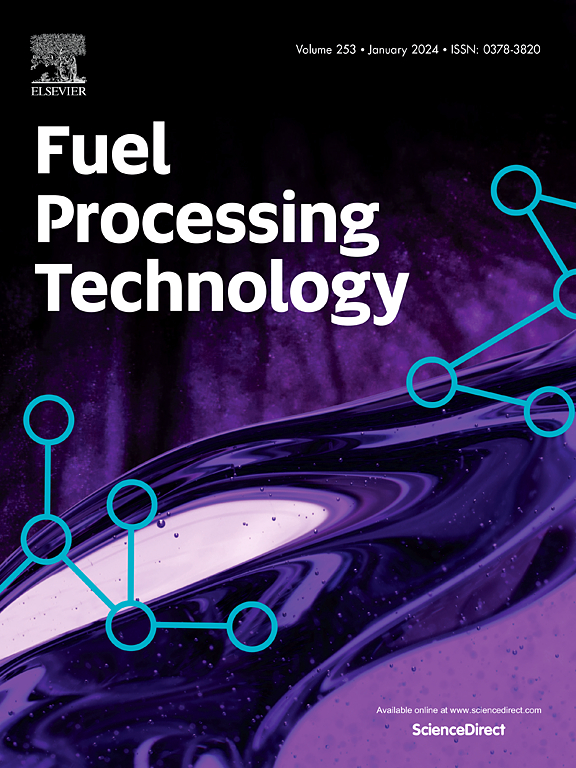Ammonia as fuel for marine dual-fuel technology: A comprehensive review
IF 7.2
2区 工程技术
Q1 CHEMISTRY, APPLIED
引用次数: 0
Abstract
Decarbonizing maritime transportation is a key objective for the future green shipping industry, with ammonia emerging as a promising candidate among hydrogen carriers and alternative fuels for CO2-free energy systems. Its benefits include high volumetric hydrogen density, low storage pressure, high storage temperature than other alternative fuels, and long-term stability. This comprehensive review analyzes over 300 studies, researches and experiments from 2001 to 2024, evaluating the potential of ammonia supply systems for dual-fuel engines in both current and future maritime applications. The study explores the viability of using ammonia in dual-fuel marine diesel engines, combining it with diesel, hydrogen, biodiesel, LNG, LPG, or other fuels to achieve significant reductions in carbon emissions, supported by ammonia's low auto-ignition temperature. Maintaining the ammonia energy ratio below 60 % helps to lower the flame temperature, which in turn reduces NOx emissions. However, increasing the ammonia energy proportion also leads to higher N₂O emissions, which counterbalances the benefits of lower CO₂ emissions. Optimizing diesel injection timing helps to reduce N₂O and NH₃ emissions. Despite its potential, ammonia dual-fuel combustion still presents challenges, particularly concerning NOx emissions and high levels of unburned ammonia due to the fuel's nitrogen content. These issues necessitate the implementation of effective aftertreatment systems. Consequently, ammonia is currently regarded as a feasible option primarily for marine applications, power generation, and potentially cargo vessels, where space limitations are less restrictive. Furthermore, addressing critical factors such as safety, combustion efficiency, and technological advancements is essential before ammonia can be considered a complete replacement for conventional marine fuels.
船用双燃料氨燃料技术综述
脱碳海运是未来绿色航运业的一个关键目标,氨正在成为氢载体和无二氧化碳能源系统替代燃料的有希望的候选者。与其他替代燃料相比,它的优点包括体积氢密度高、储存压力低、储存温度高、长期稳定性好。本综合综述分析了2001年至2024年期间的300多项研究、研究和实验,评估了双燃料发动机氨供应系统在当前和未来海事应用中的潜力。该研究探索了在双燃料船用柴油发动机中使用氨的可行性,将其与柴油、氢、生物柴油、液化天然气、液化石油气或其他燃料结合使用,以显著减少碳排放,并支持氨的低自动点火温度。将氨能量比保持在60%以下有助于降低火焰温度,从而减少NOx排放。然而,增加氨能比例也会导致更高的N₂排放量,这抵消了降低CO₂排放量的好处。优化柴油喷射时间有助于减少N₂O和NH₃的排放。尽管具有潜力,但氨双燃料燃烧仍然存在挑战,特别是在氮氧化物排放和由于燃料含氮而导致的高水平未燃烧氨方面。这些问题需要实施有效的后处理系统。因此,氨目前被认为是一种可行的选择,主要用于海洋应用、发电和潜在的货船,这些领域的空间限制较少。此外,在考虑将氨气完全替代传统船用燃料之前,解决诸如安全性、燃烧效率和技术进步等关键因素至关重要。
本文章由计算机程序翻译,如有差异,请以英文原文为准。
求助全文
约1分钟内获得全文
求助全文
来源期刊

Fuel Processing Technology
工程技术-工程:化工
CiteScore
13.20
自引率
9.30%
发文量
398
审稿时长
26 days
期刊介绍:
Fuel Processing Technology (FPT) deals with the scientific and technological aspects of converting fossil and renewable resources to clean fuels, value-added chemicals, fuel-related advanced carbon materials and by-products. In addition to the traditional non-nuclear fossil fuels, biomass and wastes, papers on the integration of renewables such as solar and wind energy and energy storage into the fuel processing processes, as well as papers on the production and conversion of non-carbon-containing fuels such as hydrogen and ammonia, are also welcome. While chemical conversion is emphasized, papers on advanced physical conversion processes are also considered for publication in FPT. Papers on the fundamental aspects of fuel structure and properties will also be considered.
 求助内容:
求助内容: 应助结果提醒方式:
应助结果提醒方式:


